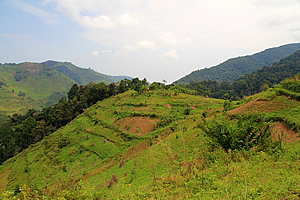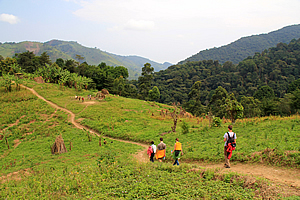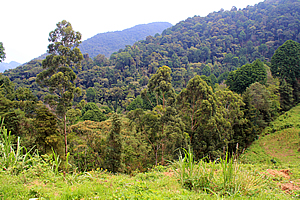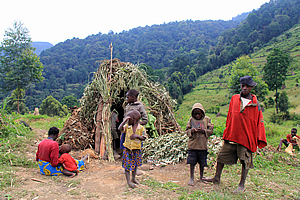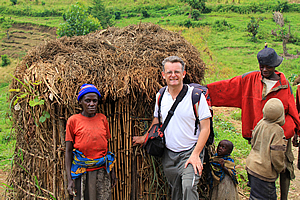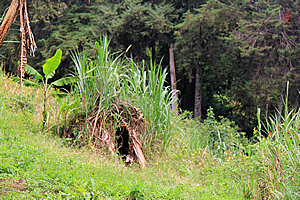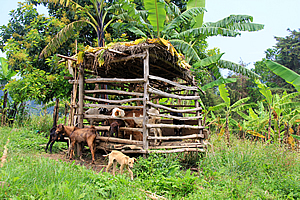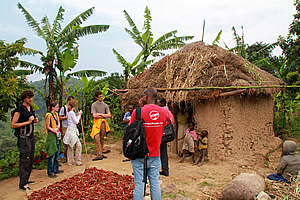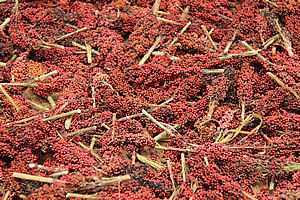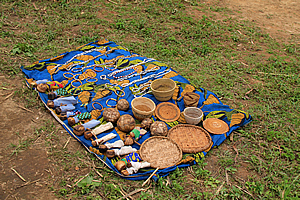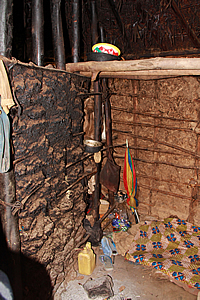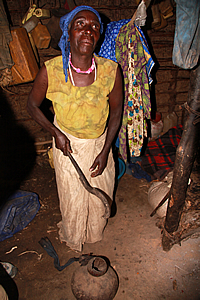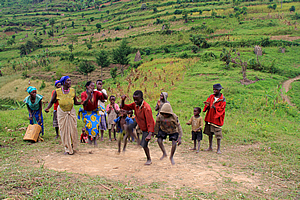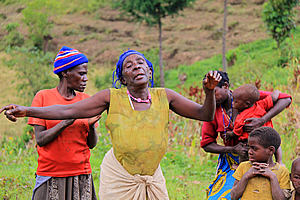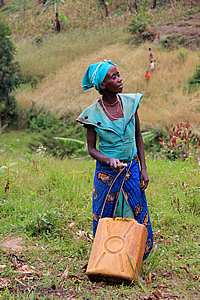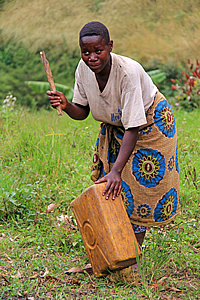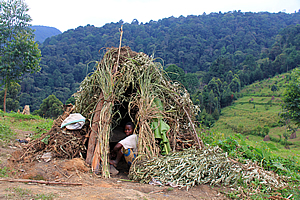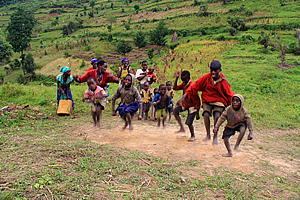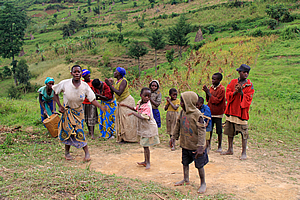--- Archive files ---
Home > Treks > Gorillas > 2.3 |
A Race Displaced and under threat of Extinction
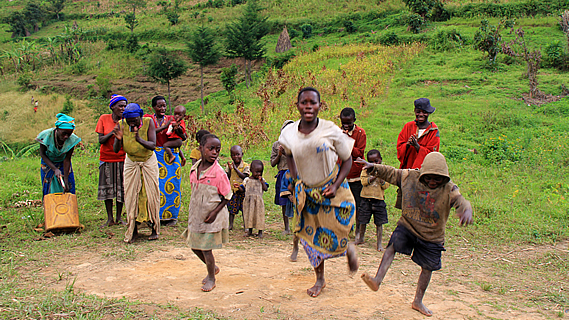
I WAS now a good hour or two hiking into the rugged wilderness from the remote ecolodge where I was staying. Out here the terrain was becoming increasingly mountainous. We were still in steep farmland where the occasional woman would be tendering the very steep fields, but a few hundred metres ahead of us was the start of the rainforest – the edge of the Congo, the second largest forest in the world. We were still in Uganda, but the official border of Congo was just four kilometres away beyond the end of the valley.
Pygmy village at the edge of the Congo |
There were far fewer people and no houses here. We approached a gully, and saw the ever roughening track approach a small hilltop at about our altitude.
On top of the hill I could just see a couple of very small crudely constructed thatched huts. They were of a far lower standard than the shack houses we had seen earlier. The huts were surrounded by a few banana trees and what appeared to be piles of straw about a metre and a half high. A small group of curious children were just below the summit obviously waiting for us.
Trail to the pygmy village |
We walked down the gully over the small saddle that separated the top of the hill from the rest of the ridge. We climbed the hundred metres of gentle slope up to a cleared area where the children were rehearsing obviously for a cultural show they were about to put on.
Then I realised they weren’t all small children. The taller ones were fully grown adults standing about 1.3 metres high. This was a tribe of pygmies – the smallest peoples on Earth.
Edge of the Congo |
We briefly rested on some crudely cut low benches where Peter briefed that this village was one of three pygmy families who had been located here. Traditionally they had lived in the forest and hunted its natural resources, but the government had in recent years removed them from the forest and gave them this small remote parcel of land.
There were three generations to this family. An elderly woman aged around 65 (though looking much older) was the obvious matriarch. Adimu had three daughters (or perhaps they were daughters in law), and numerous children. All the men were away from the village often weeks at a time to work. Nobody seemed to know where they worked, or even if that actually worked at all. For their long absences the men brought back very little money when they did return.
Villagers and a hut |
I looked over at the pile of straw vegetation nearby. Then I realised it was a small hut. Two of the children were sitting on small sofas built from some of the vegetation with some old blankets put on top. Rodney told me this was where they slept. The tiny hut had a couple of bundles of long grass tied up on either side of the tiny entrance which they could draw shut when they sleep to keep out the worst of the weather. I imagined though that when it does rain heavily, these crude huts would leak like a sieve making for a miserable sleepless night.
Posing outside one of the huts |
Below the hut was a very crude vegetable patch. Well I assumed it was a vegetable patch as the ground had been roughly dug up, but there weren’t any living vegetables in there – maybe a few dead ones, or were those weeds?
There were a few of the red flowered plant growing on the hill, and apart from the forest just behind the huts, it was the only healthy plant in existence here.
I looked at a fancier hut nearby. It was an upended cylindrical shape nearly two metres high. It was fairly recently made from dead sticks and was quite a good construction. Some of the twigs had started sprouting.
A hut with vegetation shooting out of it |
I posed with one of the pygmy women outside the hut. I think it was her hut. Like all of the other women, she had very short hair and covered her head with a woollen hat, no doubt her hair having been shaved off regularly to minimise head lice infestations. She was wearing very old ragged clothing starting to decompose in the jungle humidity like all the others. Standing in front of the hut, and next to this woman, I felt like a giant.
This had been quite a change from feeling rather diminutive next to all the other men I had seen on this trip so far. Africans are much taller than people from other parts of the world, but here in this tiny remote outpost at the edge of nowhere it was different.
Village livestock |
We walked up the final few metres up the hill, passing a group of banana plants without any bananas on them. Once past the bananas we had a very good view across to the forest covering the hills from here onwards. A short distance down the hill was another straw hut that was mostly camouflaged by some large bits of vegetation that had sprouted and growing about two metres high, the shoots now dwarfing the hut. It seemed the perfect place for a snake or other dangerous creature to be lurking.
Main village area |
A few more metres up the hill stood another conical hut made from sticks fairly recently. It had two large sections of log length blocking the doorway and a plastic bowl and a metal bowl outside the entrance, perhaps for washing up before you enter.
Further up the hill we approached some of the larger huts. The small huts at about 1.2 by 1.2 metres and 1.3 metres high were for the single women. The larger huts were about the size of the Masai huts I had seen in Kenya. The main difference though they were round with a higher roof. We crammed into the largest hut with the old lady Adimo who showed us around her meagre possessions, mainly small metal cooking pots. It was very dark inside.
There was one small wooden pen made from small branches with a thatched roof. Apart from the thatching it was open to the elements. Inside the hut was a small herd of goats. There were a few outside as well. This was obviously where they spend the night. The pen was tiny, but perhaps this was how they were kept here. I imagined they used the goats for meat, milk, and for keeping the grass down.
Berries drying out for sale |
There was a small clearing around the huts where a large grass mat was laid out and covered with the red flowers we had earlier seen. They were actually small berries and no doubt for sale.
By now though, I realised these people were clearly segregated from the rest of the village. They would find it hard to sell anything here. In fact the atmosphere here was very sombre in sharp contrast to the jovial atmosphere of the main village. Here the villagers showed obvious signs of smoking dope, though they weren’t doing it in view of us. Their fields were unkempt and overgrown and unproductive. The sheet with the red berries was the only sign of any productivity here. They clearly showed they had lost their will to exist since being evicted from the forest.
Handcrafts for sale |
All up there are about 3000 pygmies. They had been evicted from the forest about fifteen years ago by the government as a measure to conserve the wildlife. The government has attempted to train and fund their new lifestyle as part of the attempt to integrate them into what they considered acceptable society, but it is very difficult to them to accept as they have no concept of money. They have intermarried with other locals so there could very well be just thirty real pygmies left.
Adimo was the matriarch of the village, and she allowed us into her hut – the only mud brick house in this village. It was a lot smaller than the huts in the village back along the trail, but it had a circular thatched roof and was a lot more solid than the other huts up here. A pole stood on the ground to support the top of the roof about three metres high. This must be a mansion by their standards.
Utensils and bedding inside the main hut |
Adimo shows us around her hut |
Three small boulders were sitting on the floor in one corner of the hut. The stones concealed the ashes of what was obviously a very crude fireplace. A plastic container of water was sitting in the corner no doubt for if the fire were to start getting out of control.
Villagers dancing |
The woman showed us some of her ceramic pots and utensils including a sickle, but she was obviously too doped up to be able to put any kind of structure into her presentation.
We returned outside to where the blanket of red seeds was. We discussed that for a white before returning down the hill for a short cultural display. We took our seats on the rugged plank benches. In front of us was a blanket containing small bowls and trinkets mostly made from reed grass and wood. Australian customs definitely won’t let these through, so I didn’t buy any. I would have like to have bought some, but then again they weren’t really helping themselves. No doubt most of their cultivation activities were the dope they were growing hidden in the jungle.
Villagers dancing |
The village women and children lined up in front of us. One of the young women had a stick and a plastic water can which was used as a drum. The older woman took to the front where she explained in a slightly drugged manner that they were going to perform a dance to celebrate the harvest. What harvest I thought.
There were four young women, one holding a baby who, judging from its squeals, clearly didn’t want to be there. There were nine small children. I’m not sure if the older children from here were attending the school. It would have been a long walk for them each day if they did go.
Drummer |
Drummer |
The drum started beating a steady strong rhythm and the old lady started her dance. Then some of the children joined in performing a rather chaotic dance. They were jumping up and down and flaying their arms around. As each would grow tired they would go back to the stationary line and someone else would take their place. There was a lot of unintelligible yelling chanting. The baby wasn’t at all happy and started screaming in the midst of it all.
A woman inside her hut |
Finally the dancing stopped briefly and Rodney discussed a bit more about their culture, how they had lived in the Congo for thousands of years and were now living here helped out by the government. To be honest I thought they would have done better back in the jungle where they had their old customs and values that had kept them going for so long. Now they were on the verge of extinction.
The drum started again and Adimu started dancing and chanting again. Some of the others joined in as they had done before. One of the ladies had large breasts and was obviously not wearing a bra, but that didn’t seem to deter her.
Villagers dancing |
The young lady banging the drum seemed a lot nicer than the others. Although her clothes were ragged, they were of a pretty blue colour with patterns that made her look really pretty. Everyone else was dressed in old rags. Everyone else was now clapping the rhythm.
A couple of the children were losing interest and they slunk off into the tiny grass hut nearby. How two of them fitted in there I had no idea. But then again they were very small people.
Villagers dancing |
The lady on the drum handed it over to the lady in the dirty cream top and big breasts whilst she disappeared towards the forest – probably to have another joint. Five minutes later she returned and abruptly took the drum back whilst everyone was still dancing. They continued singing and chanting and clapping songs, no doubt traditional folk songs that reminded them of their days back in the jungle.
The young ones would have always lived here. The young women probably wouldn’t remember life in the jungle, but the old woman Adimu definitely had memories of her old life in the jungle. She recollected how wonderful life had been where they were all able to sustain themselves. Getting evicted had changed all that. This was her way of telling the world about their situation.
<< Previous | Next >> |
|
||
About this Page
|
||
|
|
|
Where is Walkabout Jeff? |
|
|
|
|
What is happening in Walkabout Jeff's hometown?
|
|
|
|
|
Who is Walkabout Jeff?Any normal person's idea of going out involves going to the local pub for a drink with a few mates. Walkabout Jeff isn't normal.
|
|
|
|
|
